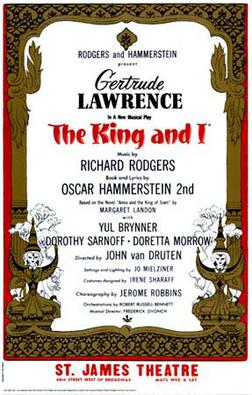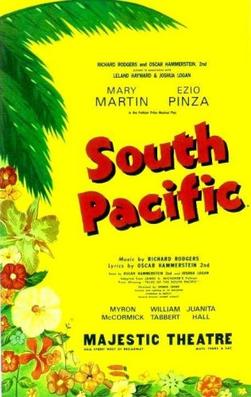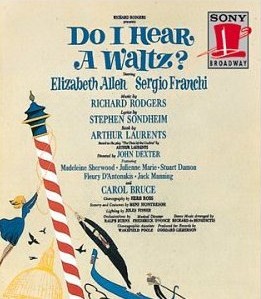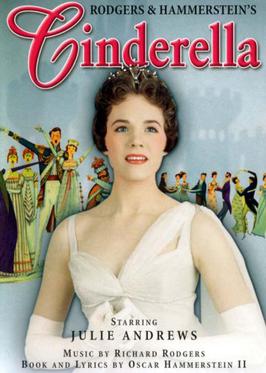
Oscar Greeley Clendenning Hammerstein II was an American lyricist, librettist, theatrical producer, and director in musical theater for nearly 40 years. He won eight Tony Awards and two Academy Awards for Best Original Song. Many of his songs are standard repertoire for vocalists and jazz musicians. He co-wrote 850 songs.

Mary Virginia Martin was an American actress and singer. A muse of Rodgers and Hammerstein, she originated many leading roles on stage over her career, including Nellie Forbush in South Pacific (1949), the title character in Peter Pan (1954), and Maria von Trapp in The Sound of Music (1959). She was named a Kennedy Center Honoree in 1989. She was the mother of actor Larry Hagman.

Richard Charles Rodgers was an American composer who worked primarily in musical theater. With 43 Broadway musicals and over 900 songs to his credit, Rodgers was one of the most well-known American composers of the 20th century, and his compositions had a significant influence on popular music.
Mary Rodgers was an American composer, screenwriter, and author. She wrote the novel Freaky Friday, which served as the basis of a 1976 film starring Jodie Foster, for which she wrote the screenplay, as well as three other versions. Her best-known musicals were Once Upon a Mattress and The Mad Show, and she contributed songs to Marlo Thomas' successful children's album Free to Be... You and Me.

The King and I is the fifth musical by the team of Rodgers and Hammerstein. It is based on Margaret Landon's novel Anna and the King of Siam (1944), which is in turn derived from the memoirs of Anna Leonowens, governess to the children of King Mongkut of Siam in the early 1860s. The musical's plot relates the experiences of Anna, a British schoolteacher who is hired as part of the King's drive to modernize his country. The relationship between the King and Anna is marked by conflict through much of the piece, as well as by a love to which neither can admit. The musical premiered on March 29, 1951, at Broadway's St. James Theatre. It ran for nearly three years, making it the fourth-longest-running Broadway musical in history at the time, and has had many tours and revivals.

Oklahoma! is the first musical written by the duo of Rodgers and Hammerstein. The musical is based on Lynn Riggs's 1931 play, Green Grow the Lilacs. Set in farm country outside the town of Claremore, Indian Territory, in 1906, it tells the story of farm girl Laurey Williams and her courtship by two rival suitors, cowboy Curly McLain and the sinister and frightening farmhand Jud Fry. A secondary romance concerns cowboy Will Parker and his flirtatious fiancée, Ado Annie.

South Pacific is a musical composed by Richard Rodgers, with lyrics by Oscar Hammerstein II and book by Hammerstein and Joshua Logan. The work premiered in 1949 on Broadway and was an immediate hit, running for 1,925 performances. The plot is based on James A. Michener's Pulitzer Prize–winning 1947 book Tales of the South Pacific and combines elements of several of those stories. Rodgers and Hammerstein believed they could write a musical based on Michener's work that would be financially successful and, at the same time, send a strong progressive message on racism.

Rodgers and Hart were an American songwriting partnership between composer Richard Rodgers (1902–1979) and the lyricist Lorenz Hart (1895–1943). They worked together on 28 stage musicals and more than 500 songs from 1919 until Hart's death in 1943.

Rodgers and Hammerstein was a theater-writing team of composer Richard Rodgers (1902–1979) and lyricist-dramatist Oscar Hammerstein II (1895–1960), who together created a series of innovative and influential American musicals. Their musical theater writing partnership has been called the greatest of the 20th century.

Flower Drum Song was the eighth musical by the team of Rodgers and Hammerstein. It is based on the 1957 novel, The Flower Drum Song, by Chinese-American author C. Y. Lee. It premiered on Broadway in 1958 and was then performed in the West End and on tour. It was adapted for a 1961 musical film.

Do I Hear a Waltz? is a musical with a book by Arthur Laurents, music by Richard Rodgers, and lyrics by Stephen Sondheim. It was adapted from Laurents' 1952 play The Time of the Cuckoo, which was the basis for the 1955 film Summertime starring Katharine Hepburn.

Robert Russell Bennett was an American composer and arranger, best known for his orchestration of many well-known Broadway and Hollywood musicals by other composers such as Irving Berlin, George Gershwin, Jerome Kern, Cole Porter, and Richard Rodgers.

Rodgers and Hammerstein's Cinderella is a musical written for television, but later played on stage, with music by Richard Rodgers and a book and lyrics by Oscar Hammerstein II. It is based upon the fairy tale Cinderella, particularly the French version Cendrillon, ou la petite pantoufle de verre, by Charles Perrault. The story concerns a young woman forced into a life of servitude by her cruel stepmother and self-centered stepsisters, who dreams of a better life. With the help of her fairy godmother, Cinderella is transformed into a princess and finds her prince.

"Edelweiss" is a show tune from the 1959 Rodgers and Hammerstein musical The Sound of Music. It is named after the edelweiss, a white flower found high in the Alps. The song was created for the 1959 Broadway production of The Sound of Music, as a song for the character Captain Georg von Trapp. In the musical, Captain von Trapp and his family sing this song during the concert near the end of Act II. It is a statement of Austrian patriotism in the face of the pressure put upon him to join the navy of Nazi Germany following the Anschluss. It is also Captain von Trapp's subliminal goodbye to his beloved homeland, using the flower as a symbol of his loyalty to Austria. In the 1965 film adaptation, the song is also sung by the Captain earlier in the film when he rediscovers music with his children.

Theater in the United States is part of the old European theatrical tradition and has been heavily influenced by the British theater. The central hub of the American theater scene is Manhattan, with its divisions of Broadway, Off-Broadway, and Off-Off-Broadway. Many movie and television stars have gotten their big break working in New York productions. Outside New York, many cities have professional regional or resident theater companies that produce their own seasons, with some works being produced regionally with hopes of eventually moving to New York. U.S. theater also has an active community theater culture, which relies mainly on local volunteers who may not be actively pursuing a theatrical career.
Ethan Mordden is an American author and musical theater researcher.

Pipe Dream is the seventh musical by the team of Richard Rodgers and Oscar Hammerstein II; it premiered on Broadway on November 30, 1955. The work is based on John Steinbeck's novel Sweet Thursday—Steinbeck wrote the novel, a sequel to Cannery Row, in the hope of having it adapted into a musical. Set in Monterey, California, the musical tells the story of the romance between Doc, a marine biologist, and Suzy, who in the novel is a prostitute; her profession is only alluded to in the stage work. Pipe Dream was not an outright flop but was a financial disaster for Rodgers and Hammerstein.

"Manhattan" is a popular song and part of the Great American Songbook. It has been performed by the Supremes, Lee Wiley, Oscar Peterson, Blossom Dearie, Tony Martin, Dinah Washington, Ella Fitzgerald, and Mel Torme, among many others. It is often known as "We'll Have Manhattan" based on the opening line. The music was written by Richard Rodgers and the lyrics by Lorenz Hart for the 1925 revue Garrick Gaieties. It was introduced by Sterling Holloway and June Cochran.
York Theatre is an off-Broadway theatre company based on the Upper East Side of Manhattan in New York City. Established in 1969, York Theatre is dedicated to the production of new musicals and concert productions of forgotten musicals from the past. Each season consists of three or four mainstage productions, six or more concert presentations and dozens of developmental readings. It has had several transfers of its work to larger off-Broadway theatres and to Broadway. The company was awarded a special Drama Desk Award in 1996 to its artistic director Janet Hayes Walker and in 2006 for its "vital contributions to theater by developing and presenting new musicals". The York also received a Special Achievement Outer Critics Circle Award for 50 years of producing new and classic musicals. After Walker's death in 1997, the company has been run by James Morgan.

Rodgers & Hammerstein's Cinderella is a 1997 American musical fantasy television film produced by Walt Disney Television, directed by Robert Iscove, and written by Robert L. Freedman. Based on the French fairy tale of the same name by Charles Perrault, the film is the second remake and third version of Rodgers and Hammerstein's musical, which originally aired on television in 1957. Adapted from Oscar Hammerstein II's book, Freedman modernized the script to appeal to more contemporary audiences by updating its themes, particularly re-writing its main character into a stronger heroine. Co-produced by Whitney Houston, who also appears as Cinderella's Fairy Godmother, the film stars Brandy in the title role and features a racially diverse ensemble cast consisting of Jason Alexander, Whoopi Goldberg, Bernadette Peters, Veanne Cox, Natalie Desselle, Victor Garber, and Paolo Montalban.

















